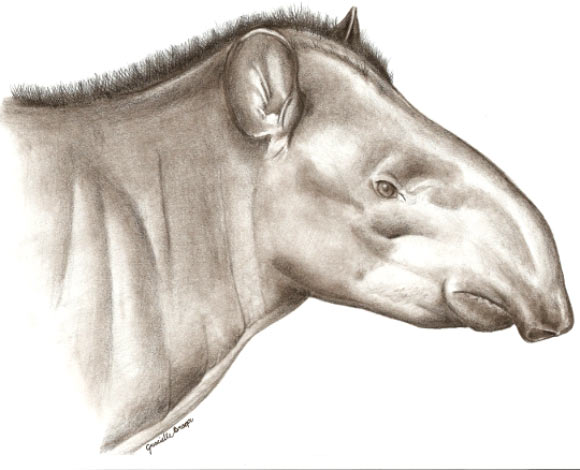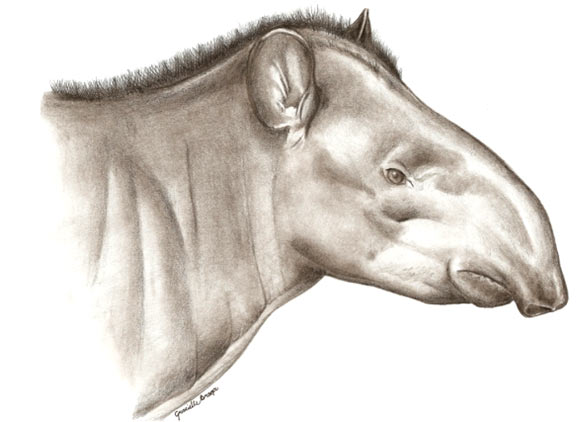Native to the forests and open savannas of Brazil and Colombia, Tapirus kabomani is the newest member of the tapir family (Tapiridae).

This is an artist’s impression of the head of a male Tapirus kabomani. Image credit: Grazielle Braga / UFMG.
Tapirs are large herbivores that belong to the Perissodactyla order of mammals.
Until now the tapir family has included four extant species: three in Central and South America – the Brazilian tapir (Tapirus terrestris), Baird’s tapir (Tapirus bairdii), the Mountain tapir (Tapirus pinchaque); and one species in Asia – the Malayan tapir (Tapirus indicus).
The fossil record of tapirs dates back to the late Eocene period (41 million years ago), and is much wider in geographical range, including Europe, Asia, and the Americas.
Tapirus kabomani is the smallest living tapir. The adults weigh around 110 kg. Shoulder height is about 0.9 m, while body length can reach 1.3 m.
The species name, kabomani, means tapir in the language of the Paumari Indians.

This camera-trap photo shows a female, left, and a male Tapirus kabomani in the southern Amazonas State, Brazil. Image credit: Cozzuol MA et al.
Externally, Tapirus kabomani differs from the similar species Tapirus terrestris by darker hair, lower mane, broader forehead, and smaller size.
“For external characters we use information from local hunters, who identified the animals in the camera-trap photos from the type locality as belonging to the new species. The hair is dark, from dark gray to dark brownish. The mane, as an external expression of the sagittal crest, is lower and starts posteriorly,” lead author Dr Mario Cozzuol and his colleagues from the Federal University of Minas Gerais wrote in a paper published in the Journal of Mammalogy.
“From the photos, specimens of known sex show that females have a gray-white area that extends from the lower jaw to the cheeks and the base of the ears, and extends ventrally to the neck, similar to that of Tapirus bairdii. Males do not show this patch and seem to be smaller. The ear tips have a white line as in all Tapirus species.”
The diet of Tapirus kabomani consists mainly of leaves and seeds of the palm trees Attalea maripa, Orbignya phalerata, and Astrocaryum aculeatum.

This is an artist’s impression of the head of a female Tapirus kabomani. Image credit: Grazielle Braga / UFMG.
According to the scientists, Tapirus kabomani inhabits the forests and open savannas of the Amazonas, Rondônia, and Mato Grosso states in Brazil and the Amazonas Department in Colombia.
“Local people’s knowledge and photographic documents also suggest that it may be present in the eastern Amazon along the Guiana Shield – Amapá in Brazil and southern French Guiana.”
“Our next stage of research is to determine the actual distribution and conservation status of the new species, which should probably be threatened, since the most common species in Brazil, Tapirus terrestris, is already considered vulnerable to extinction by the Brazilian red book of threatened species,” said co-author Prof Flávio Rodrigues.
______
Cozzuol MA et al. 2013. A new species of tapir from the Amazon. Journal of Mammalogy 94 (6): 1331-1345; doi: 10.1644/12-MAMM-A-169.1







